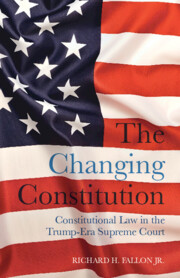Book contents
- The Changing Constitution
- The Changing Constitution
- Copyright page
- Dedication
- Contents
- Introduction
- 1 The Written Constitution and the Emergence of Judicial Supremacy
- 2 Historical Overview of Constitutional Adjudication by the Supreme Court
- 3 The Supreme Court Today
- 4 Freedom of Religion
- 5 The Freedom of Speech
- 6 The Expanding and Contested “Right to Keep and Bear Arms”
- 7 The Equal Protection of the Laws
- 8 Substantive Due Process and Unenumerated Fundamental Rights after the Overruling of Roe v. Wade
- 9 The Shrinking yet Still Formidable Powers of Congress
- 10 The Powers of the President and the Executive Branch in a Period of Ferment
- 11 Law and Change in the Supreme Court
- Index
1 - The Written Constitution and the Emergence of Judicial Supremacy
Published online by Cambridge University Press: 21 August 2025
- The Changing Constitution
- The Changing Constitution
- Copyright page
- Dedication
- Contents
- Introduction
- 1 The Written Constitution and the Emergence of Judicial Supremacy
- 2 Historical Overview of Constitutional Adjudication by the Supreme Court
- 3 The Supreme Court Today
- 4 Freedom of Religion
- 5 The Freedom of Speech
- 6 The Expanding and Contested “Right to Keep and Bear Arms”
- 7 The Equal Protection of the Laws
- 8 Substantive Due Process and Unenumerated Fundamental Rights after the Overruling of Roe v. Wade
- 9 The Shrinking yet Still Formidable Powers of Congress
- 10 The Powers of the President and the Executive Branch in a Period of Ferment
- 11 Law and Change in the Supreme Court
- Index
Summary
This chapter outlines the content of the written Constitution and describes the historical context, debates, and compromises from which the Constitution emerged. A central theme involves the emergence of “judicial supremacy” or the dominant role of the Supreme Court in constitutional interpretation. At the time of the Constitution’s ratification, many people believed that each of the branches of the national government would interpret the Constitution for itself. Moreover, the Supreme Court was not initially regarded as a particularly important institution. In order to explain the rise of judicial supremacy, the chapter begins to develop the idea, borrowed from political scientific literature, that the Court’s power exists within and is constrained by politically constructed boundaries that are constituted by the willingness of other institutions and ultimately the American people to accept the Court’s rulings as authoritative. In support of the argument that the Court’s power to interpret the Constitution authoritatively depends on the support of political officials and the American public, not the clear mandate or logical implications of the constitutional text, the chapter debunks the myth that the Supreme Court’s 1803 decision in Marbury v. Madison definitively settled the question of the Court’s interpretive authority.
Keywords
Information
- Type
- Chapter
- Information
- The Changing ConstitutionConstitutional Law in the Trump-Era Supreme Court, pp. 18 - 34Publisher: Cambridge University PressPrint publication year: 2025
Accessibility standard: WCAG 2.0 A
Content Navigation
Allows you to navigate directly to chapters, sections, or non‐text items through a linked table of contents, reducing the need for extensive scrolling.
Provides an interactive index, letting you go straight to where a term or subject appears in the text without manual searching.
Reading Order & Textual Equivalents
You will encounter all content (including footnotes, captions, etc.) in a clear, sequential flow, making it easier to follow with assistive tools like screen readers.
Structural and Technical Features
You gain clarity from ARIA (Accessible Rich Internet Applications) roles and attributes, as they help assistive technologies interpret how each part of the content functions.
